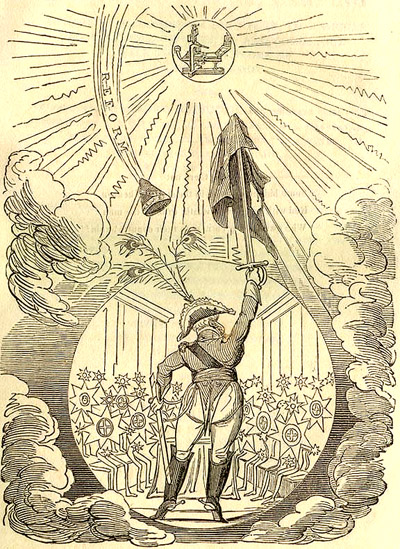The Man in the Moon, HTML front matter transcription
[Title Page - Notes]
THE
MAN IN THE MOON,
&c. &c. &c.
" If Caesar can hide the Sun with a blanket, or put
the Moon in his pocket, we
will pay him tribute for light."--Cymbelline.
WITH FIFTEEN CUTS.
Twenty-seventh Edition.
LONDON:
PRINTED BY AND FOR WILLIAM HONE,
45, LUDGATE-HILL.
1821.
[Dedication - Notes]
Dedicated
TO THE
RIGHT HON. GEORGE CANNING,
AUTHOR OF PARODIES ON SCRIPTURE, TO RIDICULE
HIS POLITICAL OPPONENTS, AND COLLEAGUE
WITH THE PROSECUTORS OF
POLITICAL PARODY:
WHO,
AFTER LAMPOONING LORD SIDMOUTH,
AND HOLDING HIM UP TO
THE SCORN AND CONTEMPT OF ALL ENGLAND, AS A CHARLATON
AND "PRIME DOCTOR TO THE COUNTRY," NOW TAKES
A SUBORDINATE PART UNDER HIM AS
A "PRIME" MINISTER:
WHO,
AFTER DENOUNCING LORD CASTLEREAGH'S
INCAPACITY FOR
INFERIOR OFFICE, AND CONFIRMING THAT DENUNCIATION BY HIS
PISTOLS, ACCEPTED INFERIOR OFFICE HIMSELF UNDER THE
CONTROL OF THAT VERY LORD CASTLEREAGH;
AND
SEEKS TO PROLONG HIS POLITICAL EXISTENCE
BY THE FAWNING BLANDISHMENT OF "MY
NOBLE FRIEND," ALTHOUGH THAT
"NOBLE FRIEND" HAS NOT BEEN
OBSERVED TO ENCOURAGE
THE EMBARRASSING ENDEARMENT,
BY RETURNING IT:
THUS,
BY HIS PARODIES,
HIS PISTOLS AND HIS WITS,
FIGHTING AND WRITING HIS WAY
TO PLACE AND PROFIT UNDER MINISTERS,
WHOM THE DERISION OF HIS PEN
HAS DRIVEN TO THE MISERY
OF HIS ALLIANCE.
Notes:
1. Title Page: Cruikshank's engraving carries most of the semantic weight of the title page. The central figure is, of course, the Prince Regent standing before the "lunatarian" Parliament displaying his ample posteriors to the pamphlet's readers. The Prince is trying ineffectually to "hide the Sun with a blanket," as the epigraph from Cymbeline (III.i) suggests. In this case, the sun is an emblem of the free press and the Prince's three scrawny peacock plumes (a parodic portrayal of the insignia of the Prince of Wales) is about to be squashed by a Cap of Liberty. The political message could hardly be more clear.
Interestingly, the engraving is composed of precisely the same fundamental elements that had figured so prominently in The Political House that Jack Built. That pamphlet had prominently featured Hone's printing press as "The Thing" that would make possible the cause of reform and the Prince Regent as the ridiculous "Dandy of Sixty." And the Political House closes with an image of a triumphant Cap of Liberty. [return]
2. Epigraph: The epigraph is taken from Joseph Addison's "Cato: A Tragedy," lines I.1.21-24. Given the context provided by the title page image, it would seem to express a sense of outrage and perhaps a desire for revenge against the Prince Regent, one of those "Who owe their greatness to their country's ruin." Certainly a more extended view of the Addison passage suggests that Hone was thinking specifically of the Peterloo massacre.
Addison's character Marcus envisions the recent skirmish:
3. Dedication: George Canning was prominent in the Tory administrations during the first three decades of the nineteenth century, rising even to the position of Prime Minister in the few months before his death in 1827. The multiple ironies of Hone's "Dedication" to Canning come clear if one recognizes two key historical contexts:
First, in 1817 Hone was tried before the King's Court on three charges of blasphemous libel for having written and published political parodies based on the language and forms of English church liturgy. The government argued, in essence, that any parody of scriptural language constituted a blasphemous undermining of religion. In defending himself, Hone drew on his impressive knowledge of literary and print history, citing example after example of scriptural parodies, many by eminent ecclesiastical or governmental authorities. One of the writers Hone cited in his own defence was none other than George Canning, who had also produced a liturgical parody when he was associated with The Anti-Jacobin in the late 1790s.
Second, in 1809, Canning fought a duel with Lord Castlereagh, which, of course, both survived though Canning was wounded in the leg. (The dispute was over a matter of policy: in Canning's view, Castlereagh's actions as War Secretary had led to several disasters for the British forces.) Later, the two mended their relationship well enough to be able to serve in the same Cabinet, and, at the time of Hone's Man in the Moon, both were prominent once again in the government. Along with the Home Secretary, Lord Sidmouth, whom Canning had earlier nicknamed "the Doctor" after his father's profession, the three men made up a "guilty trio" of governmental misrule.
These events offer the explanatory background to Hone's claims in the "Dedication" that Canning "by his parodies, / his pistols and his wits" fought and wrote his way "to place and profit." They explain, too, why Canning was the focus of such personal animosity on Hone's part--to Hone he was the very embodiment of hypocrisy and repressive violence. [return]
